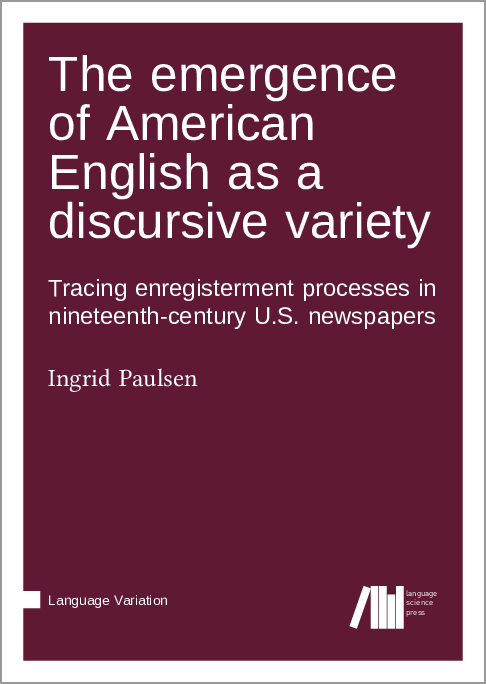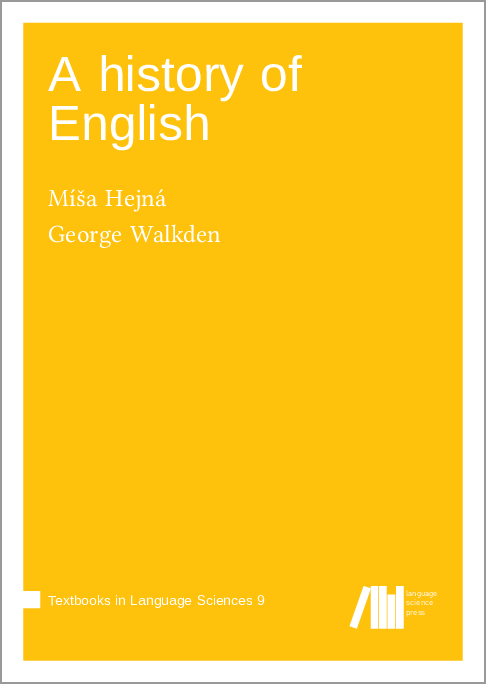In der letzten Zeit sind u.a. diese frei verfügbaren Titel erschienen:
The emergence of American English as a discursive variety: Tracing enregisterment processes in nineteenth-century U.S. newspapers
Ingrid Paulsen
https://langsci-press.org/catalog/book/341 & https://doi.org/10.5281/zenodo.6207627

Do speakers’ identity constructions influence the emergence of new varieties of a language? This question is at the heart of a debate about how the process of the emergence of postcolonial varieties of English can best be modeled. This volume contributes to the debate by linking it to models and theories proposed by anthropological linguists, sociolinguists and discourse linguists who view identity as a social and cultural phenomenon that is produced through linguistic and other social practices. Language is seen as essential for identity constructions because speakers use linguistic forms that index social ‘personae’ as well as specific social practices and values to convey an image of self to other speakers.
Based on the theory of enregisterment that models the cultural and discursive process of the creation of indexical links between linguistic forms and social values, the argument is made that any model of the emergence of new varieties needs to differentiate carefully between a structural level and a discursive level. What emerges on the discursive level as a result of processes of enregisterment is a ‘discursive variety’. The volume illustrates how the emergence of a discursive variety can be systematically studied in a historical context by focusing on the enregisterment of American English as it can be observed in nineteenth-century U.S. newspapers. Using a discourse-linguistic methodological framework and two large databases containing close to 78 million newspaper articles, the study reveals a complex pattern of indexical links between the phonological forms /h/-dropping and ‑insertion, yod-dropping, a lengthened and backened bath vowel, non-rhoticity, a realization of prevocalic /r/ as a labiodental approximant as well as the lexical items baggage and pants on the one hand and social values centering around nationality, authenticity and non-specificity on the other hand. Qualitative analyses uncover the social personae associated with the linguistic forms (e.g. the American cowboy, the African American mammy and the ‘Anglo-maniac’ American dude), while quantitative analyses trace the development over time and show that the enregisterment processes were widespread and not restricted to a particular region.
A history of English
Míša Hejná & George Walkden
https://langsci-press.org/catalog/book/346 & https://doi.org/10.5281/zenodo.6560337

Where does today’s English language come from? This book takes its readers on a journey back in time, from present-day varieties to the Old English of Beowulf and beyond. Written for students with little or no background in linguistics, and reflecting the latest scholarship, it showcases the variation and change present throughout the history of English, and includes numerous exercises and sample texts for every period.
The reverse-chronological approach taken by this book sets it apart from all existing textbooks of the last fifty years. Innovative features also include its focus on variation, multilingualism and language contact, its use of texts from outside the literary canon, and its inclusion of case studies from syntax, sociophonetics and historical pragmatics.
A Short Media History of English Literature
Ingo Berensmeyer | https://doi.org/10.1515/9783110784459
This book explores the history of literature as a history of changing media and modes of communication, from manuscript to print, from the codex to the computer, and from paper to digital platforms. It argues that literature has evolved, and continues to evolve, in sync with material forms and formats that engage our senses in multiple ways. Because literary experiences are embedded in, and enabled by, media, the book focuses on literature as a changing combination of material and immaterial features.
The principal agents of this history are no longer genres, authors, and texts but configurations of media and technologies. In telling the story of these combinations from prehistory to the present, Ingo Berensmeyer distinguishes between three successive dominants of media usage that have shaped literary history: performance, representation, and connection. Using English literature as a test case for a long view of media history, this book combines an unusual bird’s eye view across periods with illuminating readings of key texts. It will prove an invaluable resource for teaching and for independent study in English or comparative literature and media studies.
